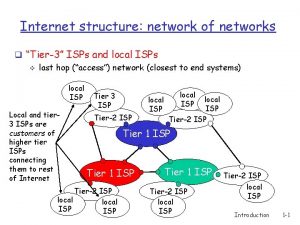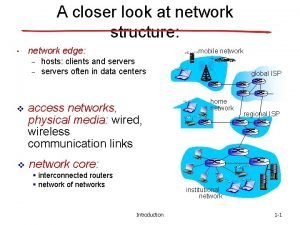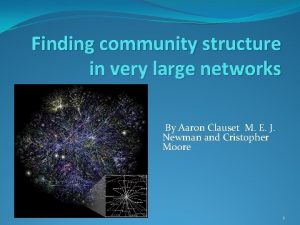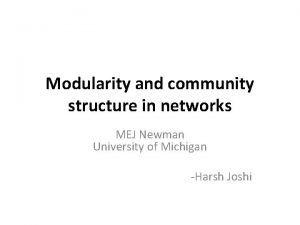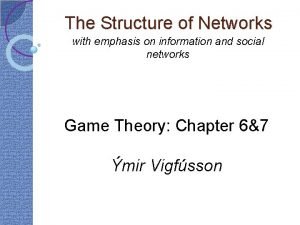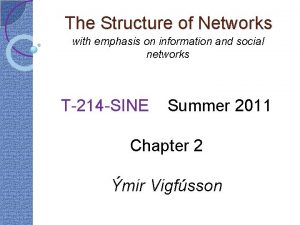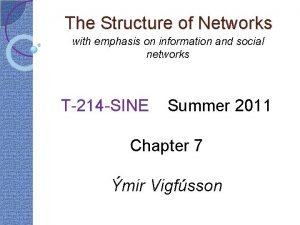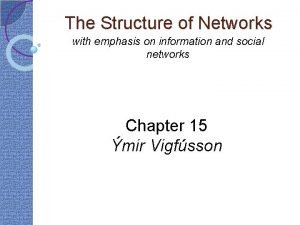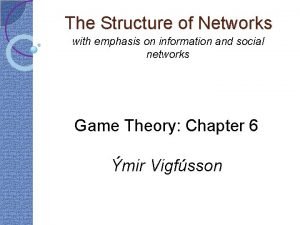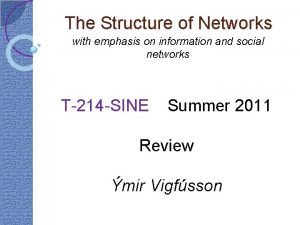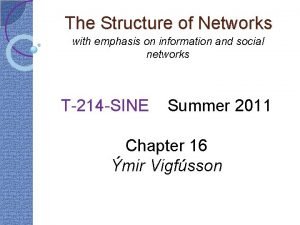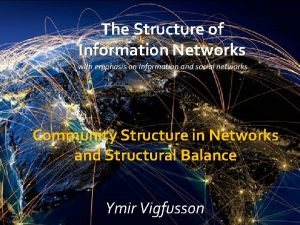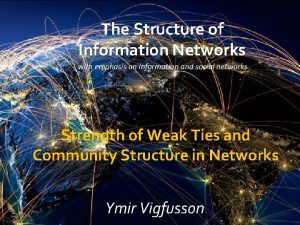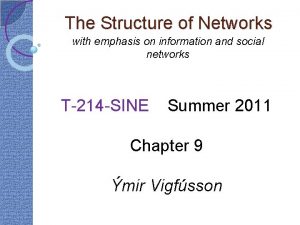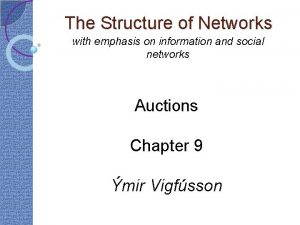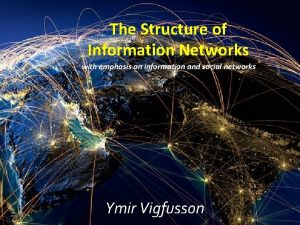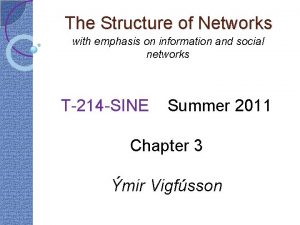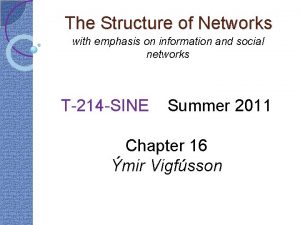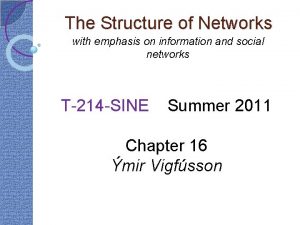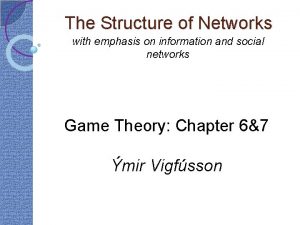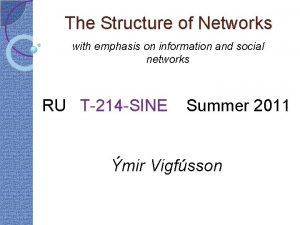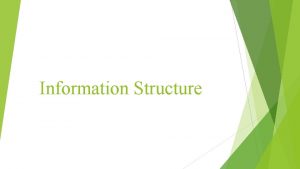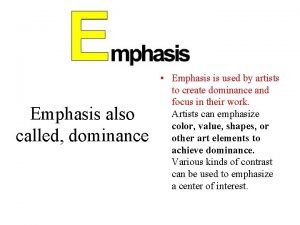The Structure of Networks with emphasis on information















































- Slides: 47

The Structure of Networks with emphasis on information and social networks T-214 -SINE Summer 2011 Chapter 8 Ýmir Vigfússon

Game theory in networks �What we have discussed so far ◦ Network structure ◦ Regular game theory ◦ Evolutionary game theory �Today we will combine game theory with networks ◦ Look at choosing a route in traffic ◦ Equivalently: network route for packets

Abstraction �Why should traffic be amenable to game theoretic reasoning? ◦ Individual don‘t choose routes in isolation ◦ They evaluate decisions of each another and reason about traffic congestion �What will we learn? ◦ Adding capacity to a network can sometimes slow down the traffic! ◦ But it‘s never too bad

Routing networks �Traffic wants to flow from some source to some destination ◦ Here, the people at s want to drive to t �Edges have latency or delay s t ◦ Latency of upper edge e depends on how many choose it ◦ Latency of lower edge e‘ always 1 hour

Routing games �All players (drivers) are making private decisions about what path to drive ◦ We now have lots of players, not just two ◦ Each wants to minimize latency of the path �This is the payoff �Suppose 10 (100) commuters on the road �What happens in the game? s t

Routing games �Players have to reason about the latency of the upper edge ◦ „How many people do I think are driving there now? “ ◦ If too many, I‘ll take the lower edge ◦ This doesn‘t give a stable outcome �More useful to ask: ◦ What is traffic like at Nash equilibrium?

Another example �Highway network, two routes. ◦ Latencies marked on the edges �Suppose 4, 000 cars go from A to B ◦ What will be the average travel time?

Another example �If everyone takes upper route ◦ 4000/100+45 = 85 minutes �If everyone takes lower route ◦ 45+4000/100 = 85 minutes

Another example �But if they divide up evenly ◦ 2000/100+45 = 65 minutes �What will happen at equilibrium?

Another example �Dividing up equally is a Nash equilibrium ◦ No driver has an incentive to switch over to the other route �This is the only Nash equilibrium ◦ Consider strategy where x drivers use upper route, and 4000 -x use lower route ◦ If x is not 2000, then routes will have unequal travel time ◦ Thus users of slower route will want to switch to the faster route �Therefore, x ≠ 2000 can‘t be a Nash equilibrium

Braess‘s Paradox �New D amazing highway is built from C to �What will happen at equilibrium? ◦ Everyone picks the A, C, D, B route!

S Slides borrowed from Luis von Ahn’s Science of the Web






















Braess‘s Paradox �Can improve analysis to show: ◦ Traffic at equilibrium is at most 33% worse than optimal

Refresher: Internet Routing �How do packets get from A to B in the Internet? A Internet B

Connectionless Forwarding �Each router (switch) makes a local decision to forward the packet towards B ◦ Does this mess up our game theory model? R 1 R 4 R 7 R 6 A R 2 B R 8 R 3 R 5

Connectionless Forwarding �This process is termed destinationbased connectionless forwarding �How does each router know the correct local forwarding decision for any possible destination address? ◦ Through knowledge of the topology state of the network ◦ This knowledge is maintained by a routing protocol

Routing Protocols �Distribute the knowledge of the current topology state of the network to all routers �This knowledge is used by each router to generate a forwarding table ◦ contains the local switching decision for each known destination address

Routing Protocols �Correct operation of the routing state of a network is essential for the management of a quality network service ◦ accuracy of the routing information ◦ dynamic adjustment of the routing information ◦ matching aggregate traffic flow to network capacity

ISP Routing Tasks �customers �internal �peer / upstream Exterior routing Interior routing Customer routing

Interior Routing Protocols �Interior Routing ◦ discovers the topology of a network through the operation of a distributed routing protocol �Describe the current network topology �Routing protocols distribute how to reach address prefix groups �Routing protocols function through either ◦ distributed computing model (distance vector)

Path Selection R 1 R 4 5 R 7 40 45 5 20 A 5 6 R 6 10 R 2 B 10 4 15 10 R 3 5 R 5 Minimum cost from A to B is 39 units 10 R 8

Dynamic Path Adjustment R 1 R 4 5 R 7 40 45 5 20 A 5 6 R 6 10 R 2 B 10 15 4 R 3 5 R 5 10 If R 5 – R 7 breaks, minimum cost path from A to B is Now 46 units R 8

Routing Protocols �Distance Vector Routing Protocols ◦ E. g. RIP protocol ◦ Each node sends its routing table (dest, distance) to all neighbors every 30 seconds ◦ Lower distances are updated with the neighbor as next hop �cannot scale �cannot resolve routing loops quickly

Routing Protocols �Link State Routing Protocols ◦ Each link, the connected nodes and the metric is flooded to all routers ◦ Each link up/down status change is incrementally flooded ◦ Each router re-computes the routing table in parallel using the common link state database ◦ OSPF is the main protocol in use today

Take away �Users at home have no say as to which of multiple routes their packets take ◦ Chosen entirely by routers �But every router is making shortest-path decisions on behalf of all the packets it forwards ◦ Routers are thus not just reasoning locally �So in practice, our game theory model works when we deal with ISP routers instead of home users ◦ Only a minor perceptual change!

Summary of what we learned �Routing games ◦ Regular/network traffic with game theory �A new road can hurt performance at equilibrium ◦ Known as Braess‘s paradox �Best response dynamics finds equilibrium ◦ Thm: Traffic at equilibrium is at worst twice as bad as optimal traffic (social optimum) �Better bound: factor of 4/3 [Tardos, Roughgarden] �Network traffic
 Contoh metode penerjemahan adaptasi
Contoh metode penerjemahan adaptasi Packet switching datagram and virtual circuit approach
Packet switching datagram and virtual circuit approach Backbone networks in computer networks
Backbone networks in computer networks Internet structure network of networks
Internet structure network of networks Internet structure network of networks
Internet structure network of networks Finding community structure in very large networks
Finding community structure in very large networks Community detection in networks
Community detection in networks Hát kết hợp bộ gõ cơ thể
Hát kết hợp bộ gõ cơ thể Lp html
Lp html Bổ thể
Bổ thể Tỉ lệ cơ thể trẻ em
Tỉ lệ cơ thể trẻ em Chó sói
Chó sói Glasgow thang điểm
Glasgow thang điểm Hát lên người ơi alleluia
Hát lên người ơi alleluia Các môn thể thao bắt đầu bằng tiếng đua
Các môn thể thao bắt đầu bằng tiếng đua Thế nào là hệ số cao nhất
Thế nào là hệ số cao nhất Các châu lục và đại dương trên thế giới
Các châu lục và đại dương trên thế giới Công thức tính độ biến thiên đông lượng
Công thức tính độ biến thiên đông lượng Trời xanh đây là của chúng ta thể thơ
Trời xanh đây là của chúng ta thể thơ Cách giải mật thư tọa độ
Cách giải mật thư tọa độ Làm thế nào để 102-1=99
Làm thế nào để 102-1=99 Phản ứng thế ankan
Phản ứng thế ankan Các châu lục và đại dương trên thế giới
Các châu lục và đại dương trên thế giới Thể thơ truyền thống
Thể thơ truyền thống Quá trình desamine hóa có thể tạo ra
Quá trình desamine hóa có thể tạo ra Một số thể thơ truyền thống
Một số thể thơ truyền thống Cái miệng nó xinh thế chỉ nói điều hay thôi
Cái miệng nó xinh thế chỉ nói điều hay thôi Vẽ hình chiếu vuông góc của vật thể sau
Vẽ hình chiếu vuông góc của vật thể sau Thế nào là sự mỏi cơ
Thế nào là sự mỏi cơ đặc điểm cơ thể của người tối cổ
đặc điểm cơ thể của người tối cổ Ví dụ về giọng cùng tên
Ví dụ về giọng cùng tên Vẽ hình chiếu đứng bằng cạnh của vật thể
Vẽ hình chiếu đứng bằng cạnh của vật thể Vẽ hình chiếu vuông góc của vật thể sau
Vẽ hình chiếu vuông góc của vật thể sau Thẻ vin
Thẻ vin đại từ thay thế
đại từ thay thế điện thế nghỉ
điện thế nghỉ Tư thế ngồi viết
Tư thế ngồi viết Diễn thế sinh thái là
Diễn thế sinh thái là Dot
Dot Số nguyên tố là số gì
Số nguyên tố là số gì Tư thế ngồi viết
Tư thế ngồi viết Lời thề hippocrates
Lời thề hippocrates Thiếu nhi thế giới liên hoan
Thiếu nhi thế giới liên hoan ưu thế lai là gì
ưu thế lai là gì Hổ sinh sản vào mùa nào
Hổ sinh sản vào mùa nào Khi nào hổ con có thể sống độc lập
Khi nào hổ con có thể sống độc lập Hệ hô hấp
Hệ hô hấp Từ ngữ thể hiện lòng nhân hậu
Từ ngữ thể hiện lòng nhân hậu



